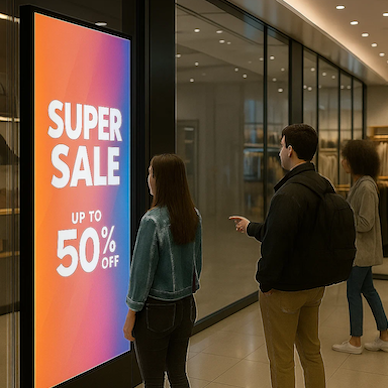Digital Signage Strategy for Newcomers
This quick-start guide will help you take the beginning steps toward an effective communication strategy
If you are a digital signage newbie, this quick-start guide will help you take the beginning steps toward an effective communication strategy. Because digital signage is part art and part science, most communicators start small with just one or two digital signs, test ideas and measure what works with their audience and then build on that. This discovery process is useful for any communications effort that involves interrupting people’s routine, because, after all, your message is not the most important thing on the mind of your viewer, or is it?
The most important thing to recognize when you start communicating by a digital sign is to realize that viewers don’t care about your message just because it’s digital unless you give them a reason to care. Certainly this applies to any communication effort. Just presenting information on a digital sign does not nullify lazy thinking or uninspiring content or other communication snafus.
Fortunately for anyone using digital signage, it has proven to be a great platform for breaking out of boring routines by experimenting with content, having a bit of fun, maybe even jolting your audience with something unexpected, and then seeking to engage your audience beyond a casual glance. For example, if your content produces a smile instead of a glance, you might just be on to something.
Because of its ability to change messages on the fly, by schedule, by data or by various environmental triggers, digital signage represents a new way of thinking about communicating. It empowers communicators to address the ways consumers, customers and employees think and act in the point-of-sale, the point-of-wait and the point-of-transit environments. Since digital signage is not print, and it’s not television, it requires a different approach.
Modern digital signage products and services provide tools to help make your in-house messages or advertising reliable, consistent, on time and of high quality. However, a tool is not a strategy in itself. No worries! These guidelines will equip you with some key facts to make your messages more engaging and appealing.
DIGITAL SIGNAGE CONTENT BASICS
When people are on the move, you have only seconds to engage them. Here are some attention-grabbing strategies to incorporate into your messages:
- Use bright colors.
- Use motion in the narrative to help tell the story.
- Keep your message cycle length appropriate to the amount of time your average customer will be in the viewing vicinity. Many successful retail message cycles are 3-10 seconds in overall length.
- Refresh signage content often to reflect sales, special offerings — and sales goals.
- Reinforce product and branding messages.
- Know your customers. Speak to their interests. Content should be dynamic and reflective of what people are doing.
- Make sure the digital media experience complements all marketing objectives, from merchandising to branding.
- Keep the look and feel of your content consistent with your brand equity.
- Avoid excessive text. Keep your messages as visual as possible.
- Don’t try to deliver full advertising messages, as you would for television, print or long-form video. Show product glimpses that pique curiosity or provide information.
- Create designs that can exist independent of sound; assume that it will not be heard. On the other hand…
- Use sound when the signage location allows it.
- Try to incorporate product tips and information.
- Experiment. Have fun.
A FEW THOUGHTS ABOUT DIGITAL SIGNAGE PLACEMENT
Don’t make this mistake: not giving much thought to sign placement, or even worse, wasting your efforts and budget on misplaced digital signs. People are not likely to look up to your ceiling for product announcements. Instead, place product-specific content where products are, preferably at eye-level or shelf level. The closer the advertising to the purchase opportunity, the more effective it will be.
Locating your signage in the optimal place and choosing the best size, the creative content can now fully stimulate the senses, arouse and influence behavior that complements the purpose of the building’s design, which reinforces and extends the core brand image. Empowered with great design, you can inspire your viewers with an aesthetic experience.
Given the time and willingness to learn from trial and error, anyone — regardless of background — can be successful with digital signage. But it’s important to shake off the common “a slide show is good enough” mentality — it’s not an effective strategy for digital signage. Sure, everyone is not a Picasso per se, but everyone is creative to some degree. A well-conceived strategy masters content that transforms digital signage from mere displays, computers and cables into a dynamic communications medium with a limitless ability to inspire, inform and motivate.
See it in Action
Get a free, no-pressure demo of our unique platform and find out how it can transform your business.









